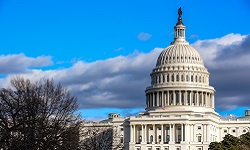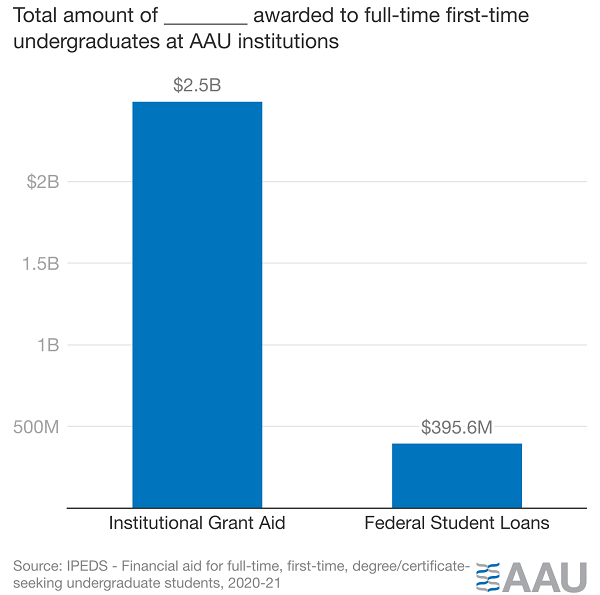 House and Senate Appropriators Propose FY24 Agency Funding Bills
House and Senate Appropriators Propose FY24 Agency Funding Bills
Last Thursday, the House Appropriations Committee released its FY24 Labor, Health and Human Services, Education, and Related Agencies funding bill. The bill proposes major cuts to health care and education programs, providing a total of $147 billion in discretionary funding, which is $60.3 billion below FY23 spending levels. The bill cuts funding for the Department of Education by $12.1 billion to $67.4 billion. A summary of the bill is available here. Provisions in the FY24 Labor-HHS-Education bill include:
- Level funding for Pell Grants – the bill freezes the maximum award at $7,395. AAU supports increasing the maximum Pell award to $13,000.
- Zero funding for Federal Work Study (a cut of $1.2 billion) and Federal Supplemental Education Opportunity Grants (a cut of $910 million).
- Funding cuts for the Institute of Education Sciences; the bill provides $707.3 million for the institute, a 12% cut from FY23.
The bill also includes several policy riders that would prevent the Biden administration from implementing policies or programs that provide for nondiscrimination on the basis of gender identity or sexual orientation, or promote diversity, equity, and inclusion. The bill would also prevent the Department of Education from moving forward with any debt relief plans or issuing new regulations designed to protect transgender athletes.
Other portions of the bill provide a total of $44.6 billion for the National Institutes of Health, a $2.8 billion cut to the NIH base from FY23 enacted levels.
House appropriators also approved the FY24 Commerce, Justice, Science, and Related Agencies funding bill in subcommittee last week. The bill provides $58 billion in discretionary funding, a cut of $24 billion (29%) from FY23 spending levels. A summary of the bill is available here. The bill includes:
- $25.4 billion for NASA, essentially flat funding compared to FY23.
- $9.63 billion for the National Science Foundation, a $91 million or 1% increase from FY23 when supplemental funding provided in FY23 is excluded. (The bill proposes to reduce funding for the STEM Education Directorate at the agency by 20%.)
- The bill also includes policy riders preventing funding for certain climate, diversity, and other programs.
Meanwhile, the Senate Appropriations Committee marked up its version of the Commerce-Justice-Science bill last week. The Senate bill funds the NSF at $9.5 billion and NASA at $25 billion; the Senate bill cuts NASA Science by $400 million. A summary of the Senate bill is available here.
 New Poll Shows Shrinking Confidence in Higher Education
New Poll Shows Shrinking Confidence in Higher Education
A new Gallup poll shows that “Americans’ confidence in higher education has fallen to 36%, sharply lower than in two prior readings in 2015 (57%) and 2018 (48%).” The decline in confidence was highest among Republicans (-37% since 2015); confidence also declined among Democrats (-9% since 2015).
Despite Americans’ shrinking confidence in higher education, as Princeton University President Christopher Eisgruber argued in a recent opinion essay, there is hardly “a more reliable and cost-effective investment than attending and completing college.”
According to a recent study by the College Board, the median earnings for full-time, year-round workers aged 25 years or older who held a bachelor’s degree in 2021 were $73,300 compared to $44,300 for workers with high school diplomas. The median earnings for workers went up further if they obtained advanced degrees. The report also found that “the unemployment rate for individuals age 25 and older with at least a bachelor’s degree has consistently been about half of the unemployment rate for high school graduates.”
Further, as Eisgruber noted in his essay, despite rising “sticker prices,” “an average year of public or private college today costs less that it did five years ago.” Another College Board study shows that, after adjusting for inflation, “the average net tuition and fee price paid by first-time full-time in-state students enrolled at public four-year institutions” was $2,250 in 2022-23 and $14,630 for students in private nonprofit four-year institutions. In the case of AAU universities, institutional grant aid offsets a significant portion of the cost of attendance. AAU universities, especially, have an impressive track record of graduating students debt-free – in 2020, only four out of 10 graduating seniors from AAU universities had debt.
Despite what the polls show and despite needed areas of improvement, Americans have a lot to be confident about in higher education. Colleges are still a primary engine of social mobility in the United States and leading research universities conduct world-changing research and innovation that improves the lives of all Americans. As Eisgurber said, college is an “investment opportunity of a lifetime.”
 Universities Weigh Options in Response to Supreme Court’s Decision on Race-Conscious Admissions
Universities Weigh Options in Response to Supreme Court’s Decision on Race-Conscious Admissions
Colleges and universities across the country are still determining the best ways to move forward after the Supreme Court’s decision to end the practice of race-conscious admissions in higher education.
Last week, University of North Carolina at Chapel Hill Chancellor Kevin M. Guskiewicz announced that, in response to the court’s decision, the university will expand opportunity by providing “free tuition and required fees for incoming undergraduates from North Carolina whose families make less than $80,000 per year.” The university has also “hired additional outreach officers” in its admissions team to spread awareness about affordability and to recruit students in under-resourced communities. (UNC was a defendant in one of the Supreme Court cases on race-conscious admissions.) Previously, Duke University also announced that it will provide full tuition for eligible students from North Carolina and South Carolina with family incomes below $150,000.
States that had already banned the use of race-conscious admissions prior to the Supreme Court’s decision also provide some insights into how colleges can continue to create diverse student bodies. According to The Chronicle of Higher Education, universities in these states have tried a variety of measures, including conducting “intentional and expanded outreach to low-income and minority students;” fine-tuning their recruitment practices; “automatically accepting a percentage of the top students from each public high school in the state;” and changing admissions criteria.
There is no guarantee, however, that such initiatives will offer universities an exact replacement for race-conscious admissions. In an amicus brief filed with the Supreme Court, the University of Michigan noted that, “despite persistent, vigorous, and varied efforts to increase student-body racial and ethnic diversity by race-neutral means,” the university saw significant drops in “the admission and enrollment of underrepresented-minority students” following Michigan’s 2006 ban on affirmative action.
News of Interest
CBS17: UNC, Duke Getting $50M from FDA to Create New Research Center – The FDA has awarded $50 million to the University of North Carolina at Chapel Hill and Duke University to set up the Research Triangle Center of Excellence in Regulatory Science and Innovation. The center will collaborate with North Carolina State University and North Carolina Central University, a historically Black institution, to conduct research that can “shorten the drug and device development process, advance public health, and inform [the FDA’s] regulatory decision-making.”
The Hill: Biden Administration Announces $39 Billion in Student Debt Relief for 804,000 Borrowers – The Education Department announced on Friday that fixes to income-driven repayment plans will lead to $39 billion in debt forgiveness for 804,000 borrowers. Under income-driven repayment plans, “the federal government cancels remaining balances for the borrower after they have made their payments for 20 or 25 years.” According to the agency, the new fixes ensure that all of borrowers’ payments are accurately counted.
Houston Chronicle: DesRoches: The Supreme Court Won’t Derail Diversity at Rice – In an opinion essay, Rice University President Reginald DesRoches expressed disappointment at the recent Supreme Court decision limiting the use of race-conscious admissions and pledged to not let it derail diversity at Rice. “We are more resolute than ever that every day at Rice, we will pursue and celebrate the excellence that a richly diverse student body, filled with its manifold experiences, brings to our community of scholars,” he wrote.
AZ Central: ‘Innovation and Job-Creation Engine’: ASU, Applied Materials to Create Research Center in Tempe – Arizona State University and Applied Materials, Inc., are partnering to create a research center “to support Arizona’s semiconductor industry and spur educational opportunities for students.” The $270 million “materials-to-fab” center will feature state-of-the-art semiconductor manufacturing equipment and help accelerate innovation in semiconductor technology and train the future semiconductor workforce. Applied Materials will contribute $200 million to the center.
The Boston Globe: How Universities Are Addressing Ongoing Collegiate Mental Health Difficulties – With more college students reporting increased anxiety and depression, colleges and universities are taking a variety of measures beyond traditional counseling services to meet students where they are. Among other things, universities are improving telehealth options, putting greater emphasis on group therapy and peer support, and creating opportunities for students to regain communal connections lost during the pandemic.
Featured Research

A new study from Brandeis University shows that hurricanes, which “gain their energy from warm sea surface temperatures,” can enhance the ocean’s “ability to absorb and store heat.” The study found that hurricanes “can push heat deep into the ocean in ways that can lock it up for years.” That heat can then be carried by ocean currents to distant parts of the planet, warming the local climate and affecting the local ecosystems.

Using Marine Bacteria to Detoxify Asbestos
Researchers at the University of Pennsylvania released a study showing that “bacteria from extreme marine environments have the potential to detoxify asbestos.” The study may eventually lead to “a desirable alternative to current asbestos treatment methods which involve either heating it to very high temperatures and pressures or by treating it with strong acids or bases.”
Stat of the Week

As AAU President Barbara R. Snyder wrote in a blog post last year, “most graduates of America’s leading research universities never go into debt to earn their degrees.” Lower- and middle-income students, especially, receive significant institutional aid from AAU universities that covers much of their education costs.
In the 2020-21 academic year, for example, AAU universities provided $2.5 billion in institutional grant aid to full-time, first-time, degree- or certificate-seeking undergraduate students. In comparison, these students received a total of $395.6 million in federal student loans. This means that, for every $1 students took out in federal student loans, they received $6.29 in institutional grants and scholarships from AAU members.